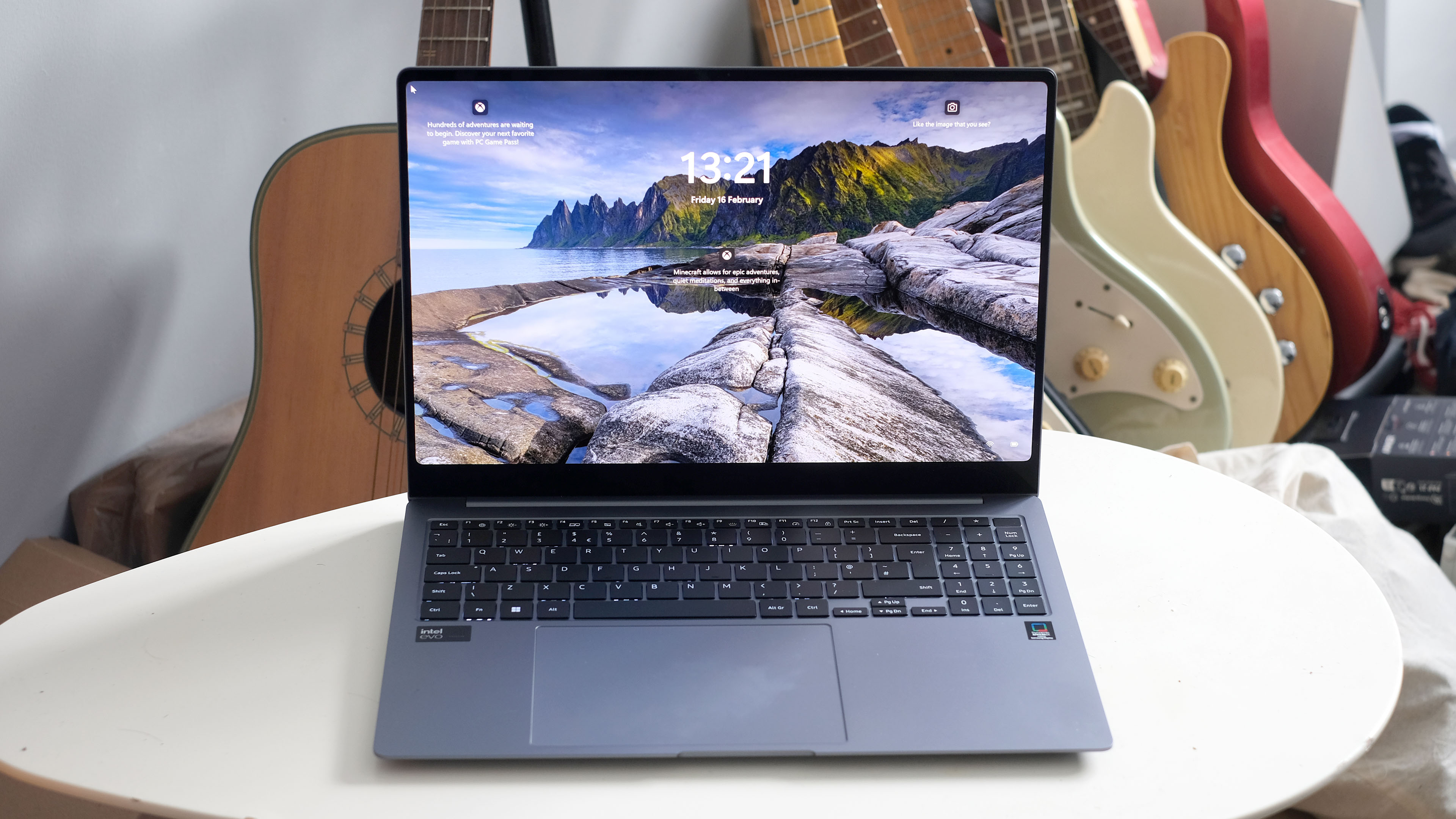
The Samsung Galaxy Book 4 Pro in 16-inch form wants to be the ultimate big-screen luxury laptop. And it gets off to a good start, featuring the OLED screen that MacBooks are reportedly going to get at some point in the future. And a touchscreen that Apple has no plans to implement.
The Samsung Galaxy Book 4 Pro is a great showcase for Intel’s latest Ultra processors too, morphing a slick exec laptop into something that can play games in a pinch thanks to the graphics baked into this new Intel CPU.
Sure, its speakers could be a touch better and the keyboard isn’t the most substantial, but this is a great option for those seeking one of the best laptops featuring a well-balanced recipe of power, portability and style.
Samsung Galaxy Book 4 Pro: Price & Release Date
The Galaxy Book 4 Pro starts at £1699 for the 16GB RAM and 512GB storage version. That jumps to £1899 if you want 1TB of space on board, or $2049 in the USA (the only specification available). It's not available in Australia.
Samsung Galaxy Book 4 Pro Review: Design
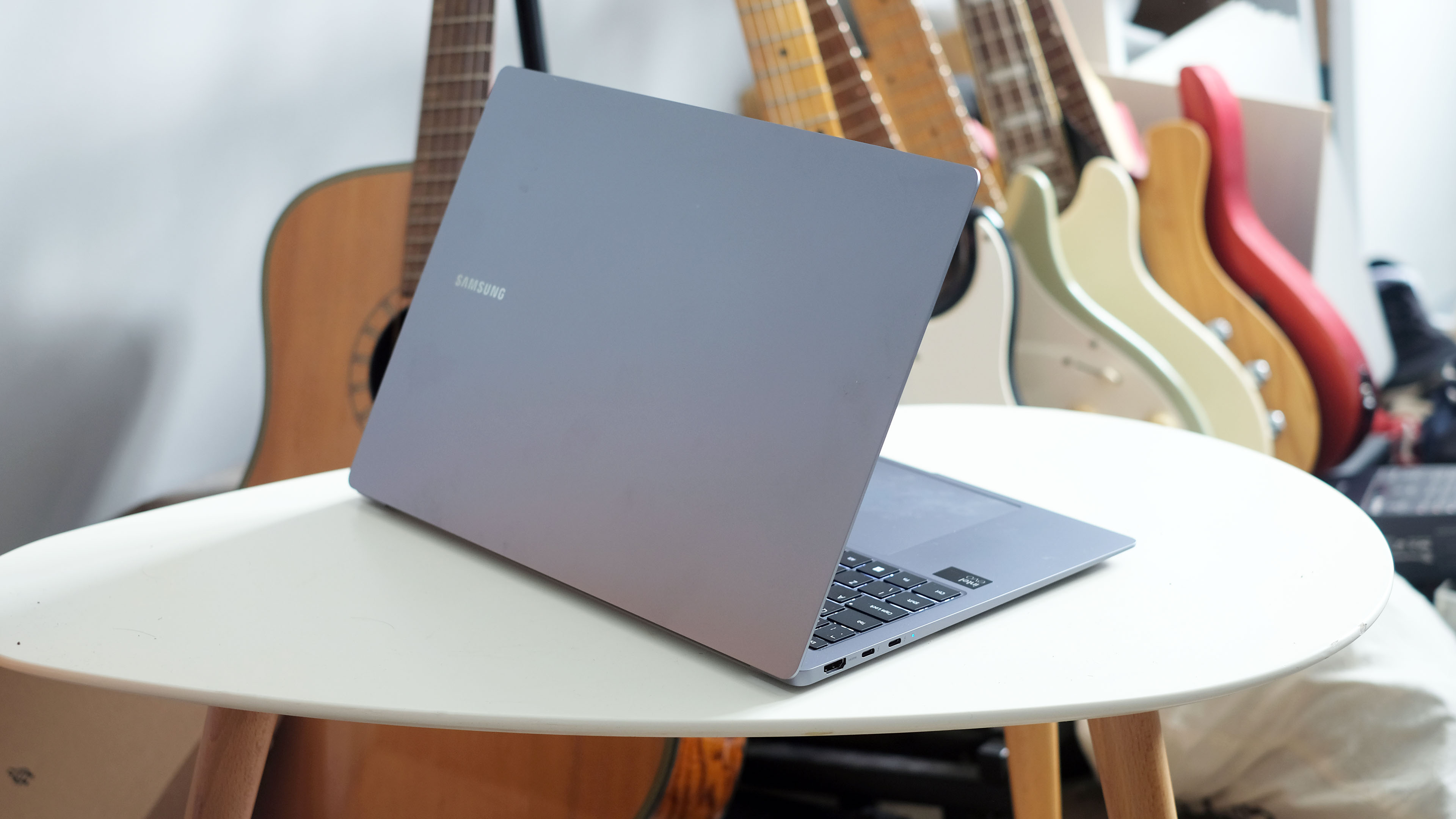
Samsung has cranked out these Book Pro series laptops since 2021. And, much as we'd be able to make a fanfare for this one, it's pretty familiar stuff – even with an imposing 16-inch screen – to the outgoing Galaxy Book 3.
We get leagues and leagues of understated metal – it's all very MacBook around these parts – while functionally the Galaxy Book 4 Pro is a different beast. This one has a NUM pad and a touchscreen, and supports stylus input (not included in the box, though, it's an extra). It's not an "everything but the kitchen sink" PC, but the touchscreen is new for this particular line.
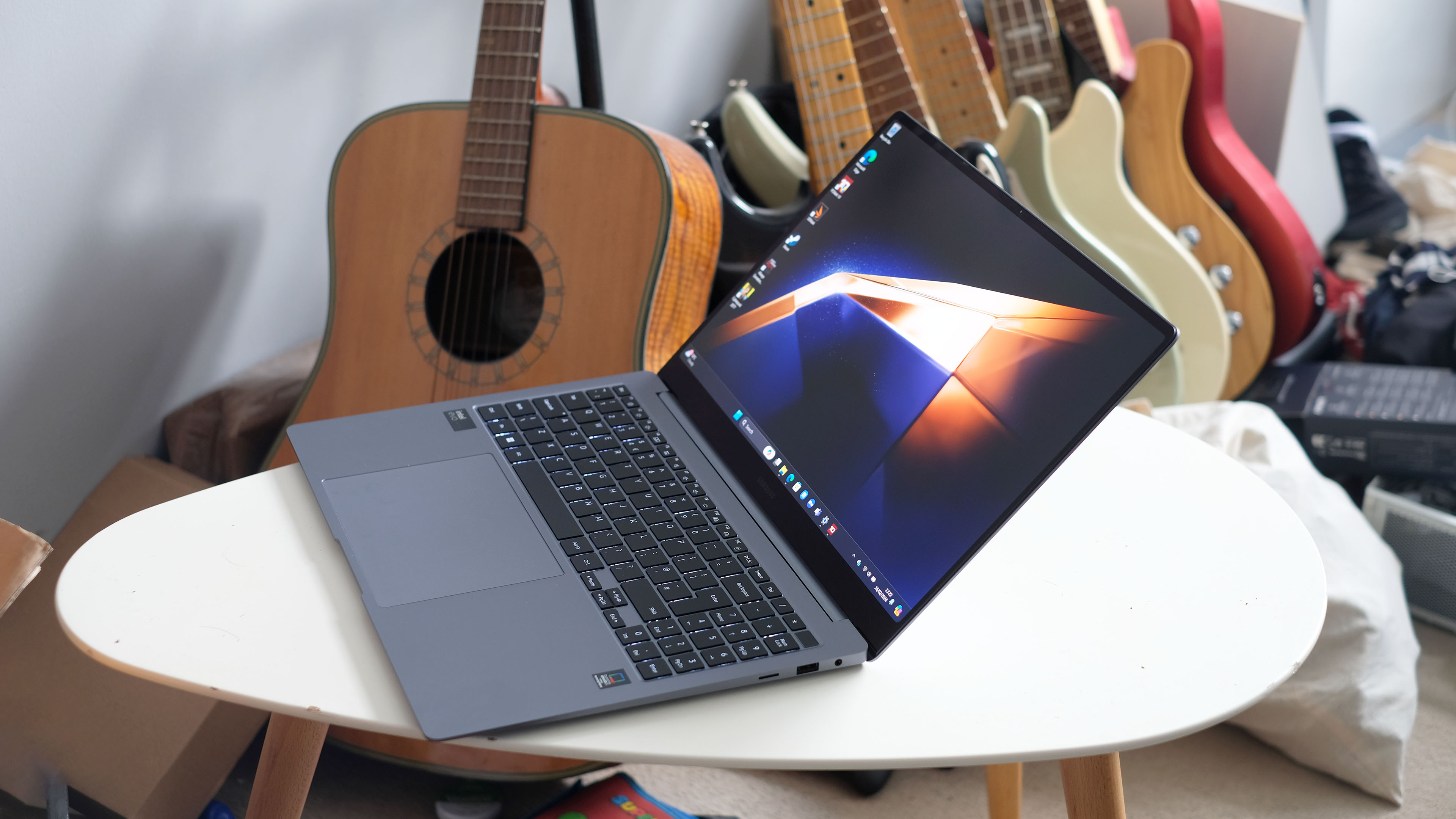
It's also fairly light and portable given it has a giant 16-inch screen. The Samsung Galaxy Book 4 Pro weights 1.66kg and is just 12.8mm thick. Sure, the LG Gram 16 makes it seem positively heavy when considering the best lightweight laptops, but the compromise here is just about perfect. I’ve used it as a pure portability PC a stack of times now, and while it maxes the width of my rucksack, the Book Pro 4 does the job just fine.
It feels dense and expensive, not a little too flexy and hollow like some LG Gram models. I’ve had issues with Samsung Galaxy Books having too-loose hinges in the past too, but not this time.
Next time it would be good to see Samsung revise the Galaxy Book 4 Pro’s speakers a bit. These ones do sound perfectly good, but just don’t have the raw volume or bass clout of the very best.
Samsung Galaxy Book 4 Pro Review: Display
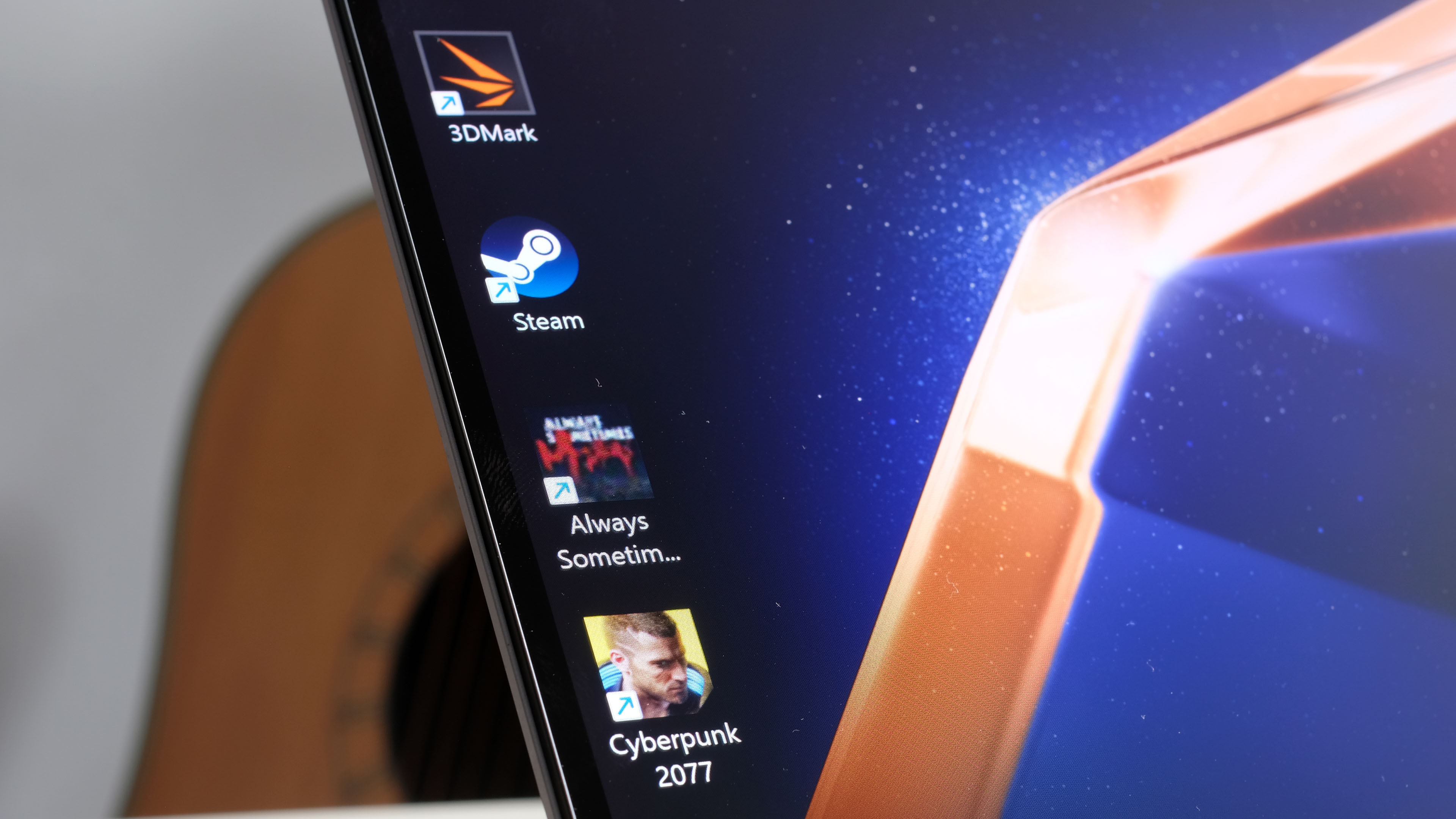
The Samsung Galaxy Book 4 Pro has a 16-inch OLED display, and it's one of the best you can find in a laptop today. That's just what you'd hope for given Samsung Display is at the cutting edge of screen tech. Colour is rich and super-accurate, and given all the more impact thanks to those lovely inky OLED blacks.
Brightness does not match the Mini LED displays of the top MacBook Pro models, though, but the figures are still above average. And, oddly enough, better than Samsung's own claims of 400 nits, or 500 when displaying HDR. I measured 400 nits with normal content, sure, but a fraction under 600 nits with HDR. Nice.
It's enough for fairly comfortable productivity use outdoors, helped by an excellent anti-reflective layer. The Samsung Galaxy Book 4 Pro has a glossy screen but reflections of strong light sources are noticeably less glaring than they appear on my MacBook Air's screen.
Sharpness is good too, thanks to the tall 3:2 aspect ratio display's 2800 x 1800 pixel resolution, even if individual pixels are more readily visible than they are in an LCD MacBook Pro. It’s a 120Hz screen, not the basic 60Hz style, which is great for fluidity.
There's just one bit that could clearly be improved. In today's OLED phones, like the Galaxy S24, the display merges seamlessly with the slim surround. In the Samsung Galaxy Book 4 Pro the screen area can take on a grey-blue whenever there's a good amount of ambient light, as if that light is being smeared across the display. You only truly get to appreciate peak OLED In a less well-lit environment.
Samsung Galaxy Book 4 Pro Review: Keyboard & touchpad
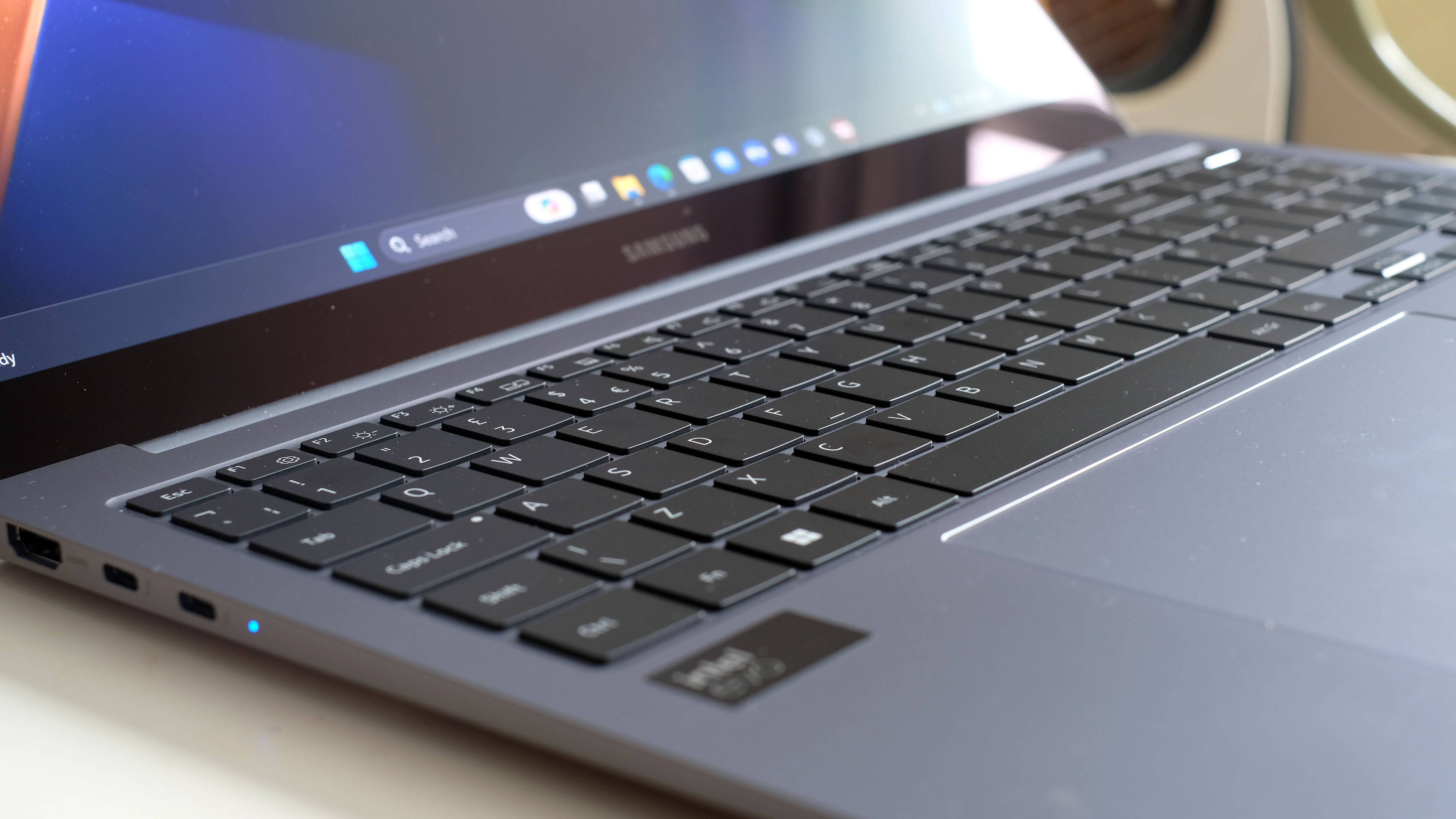
There's nothing majorly new to see in the Samsung Galaxy Book 4 Pro keyboard and touchpad. The keyboard is of good quality, but it's also on the shallow side.
Despite having the nerdy NUM pad off to the right, the keys are the standard style of a classic ultraportable. If you want a meatier feel, you'll find plenty of examples from the Asus Zenbook and Lenovo ThinkPad series, among others. Still, after bedding in for a couple of days I found I was able to type away at full speed.
The Samsung Galaxy Book 4 Pro keyboard also has a three-stage backlight, using blue-tinged white LEDs. This isn't an RGB gaming PC, after all. There's also a fingerprint reader built into the top-right most key.
It's probably the touchpad you'll notice first here because, just like last time around, this thing is absolutely massive. And while great in some respects, it also introduces the first big usability issue of the Samsung Galaxy Book 4 Pro.

Like other Windows laptops, by default this pad uses invisible zones to separate left and right mouse buttons zones. And where my finger naturally goes to use the pad? It's way over in the "right click" area. It feels like you have to deliberately move your finger over to the left just to click something.
This is always a potential problem with laptops that use NUM pads, which lead to the touchpad being shunted off to the left. Having an absolutely massive pad here seems to make the issue all the more obvious.
Within a day or two, I disabled zoned clicks completely, and used two-fingered presses for right clicks instead. It's the best way to use the Samsung Galaxy Book 4 Pro, short of digging out a mouse.
That aside, the touchpad is great, and pretty traditional. It has a mechanical clicker, not the trendy but sometimes flawed haptic kind, and good click definition with it. The surface is smooth textured glass too, so feels good.
Samsung Galaxy Book 4 Pro Review: Performance

The Samsung Galaxy Book 4 Pro is one of the first laptops out on shelves with one of Intel's Ultra-series processors. It's the Intel Ultra 7 155H. Much like you'll find in the Dell XPS 16 (although that runs at a higher power/wattage).
You can think of this as being similar to the Core-series processors laptops like this have had for years, but with much better graphics performance and more AI features.
Intel Arc is the real substance here. Not clued up on the world of graphics cards? In 2022 Intel released its first Arc graphics card, made for desktop PCs. Finally, we had a real rival to Nvidia and AMD in the space.
That tech has now been shrunk down and cut back to form an elevated sort of integrated graphics. And in plenty of situations this will net you up to double the frame rate in games, compared to a Samsung Galaxy Book Pro 3 with Intel Xe integrated graphics.
Sure, you shouldn't buy one of these if you actually want one of the best gaming laptops. For this sort of money you could get a laptop with an Nvidia RTX 4060, or even RTX 4070, from series like the Lenovo Legion 5i Pro, HP Omen 16 or MSI Pulse. None of those is nearly as swish as a Samsung Galaxy Book 4 Pro, but they'd wipe the floor with one in gaming performance.
You also need to make sure you have the Galaxy Book Pro 4 on the right setting for good results. There are four performance modes: Silent, Quiet, Optimised, High Performance. These determine how much juice the processor is allowed and how much noise its fans will make.

If you’re doing anything taxing, or playing a game, stick it on High Performance. That way, I was able to play Cyberpunk 2077 at Medium settings, 1920 x1200 resolution, at 30fps even during the more taxing driving sections.
For a bit of context, the Samsung Galaxy Book 4 Pro gets to draw a consistent 40W power in that top mode. And this drops to a relatively weedy 16-18W in Silent. The actual amount of noise generated in any of these modes is minimal, though. You can tell the fan hardware is smaller by the higher-pitch noise it makes, but this thing is unusually quiet even when working as hard as it can.
Samsung has made a compromise here, as the Intel Ultra 7 is made to draw up to 65W consistently (not 40W). Still, that would be a helluva lot for a slim laptop like this, and we’re likely to see similar limits in rivals.
General performance is great, of course, but you don't need to spend this much to get that these days. These Intel Ultra chipsets provide a massive jump in graphics, but the CPU side is much more familiar.
Samsung has tried to inject a bit more value here with a bunch of its own apps and features, but in practice it does seem a lot like a string of bloatware when you scroll down the app library.
There are some neat bits to highlight, though. Focus mode, for example, darkens the desktop when you use a windowed app, and it's actually pretty handy for concentration-heavy jobs like writing. It should save a sliver of battery thanks to the way OLED screens operate too.
You can also connect the Samsung Galaxy Book 4 Pro to a Galaxy Tab tablet (Tab S7 series or newer) and use it as a second screen too.
Samsung Galaxy Book 4 Pro Review: Battery life
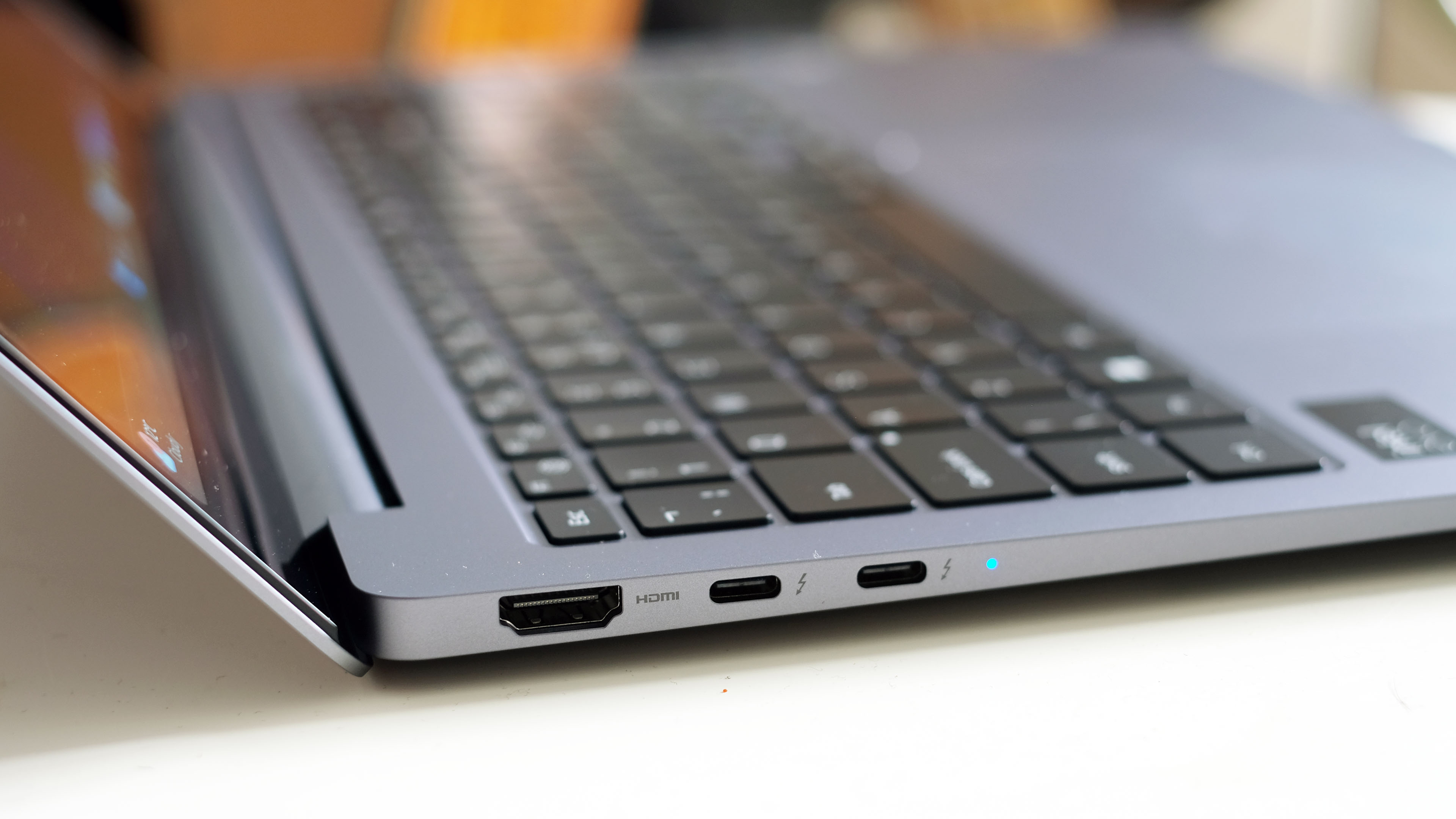
The Samsung Galaxy Book 4 Pro does not have nearly the most power-frugal processor it could have. But it also has a whacking great big 76Wh battery, and the two balance each other out rather nicely.
At the sort of moderate brightness levels you're likely to use indoors, the Samsung Galaxy Book 4 Pro can last around 10 hours when playing back video. Its stamina was even better when using the Samsung Galaxy Book 4 Pro to write up this review, alongside a little bit of web browsing, creeping up closer to the 11-hour mark. These aren't the highest numbers I've ever seen, but for a moderately performance-drive PC, it's not bad at all.
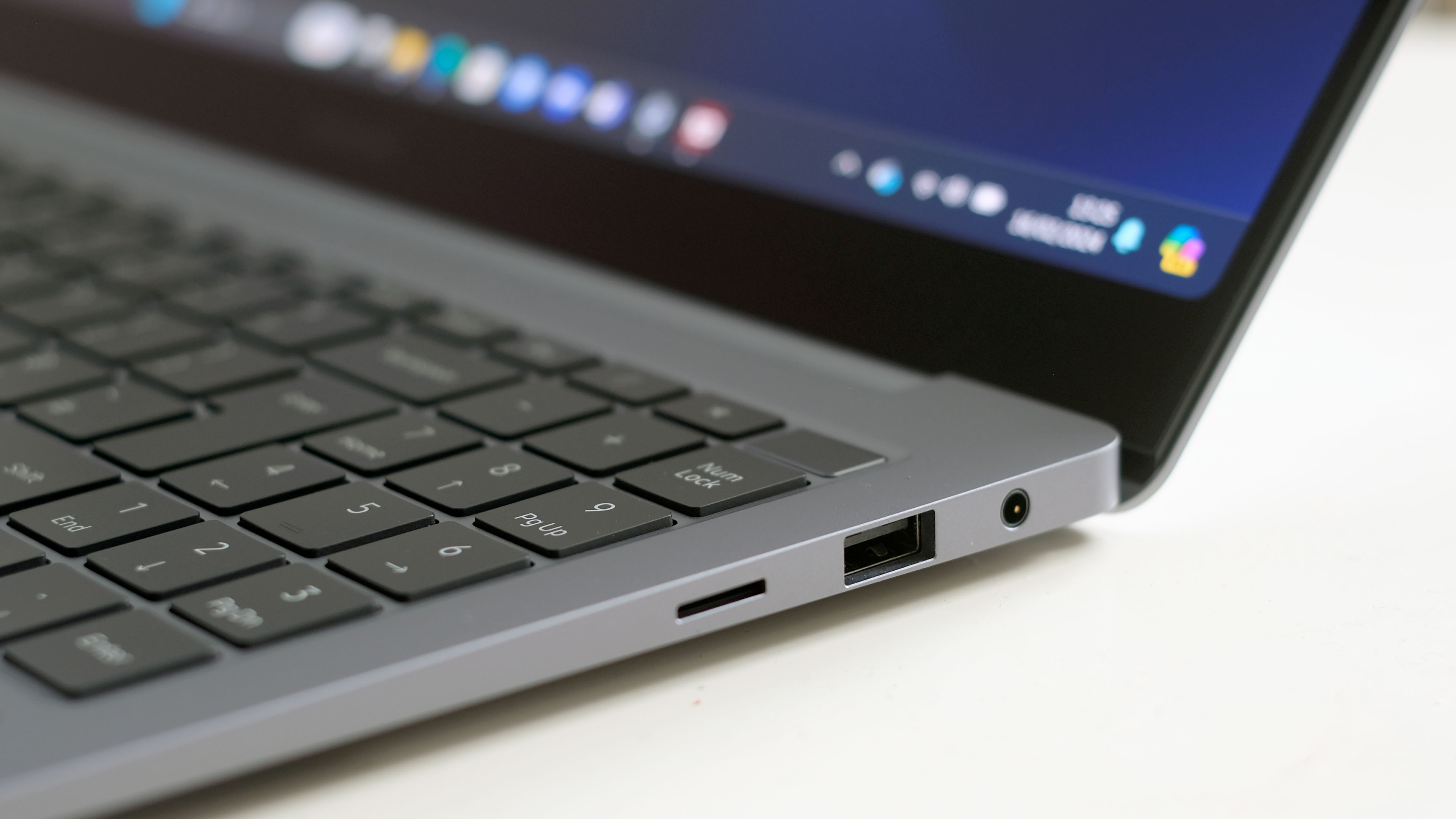
Like the last generation in this series, the Samsung Galaxy Book 4 Pro uses a slim phone-like charger for bonus portability cred.
It's also good to see Samsung, like Apple (finally), hasn't just made do with the barest selection of ports. The Galaxy Book 4 Pro has two ultra-fast USB-Cs with Thunderbolt 4 support, an HDMI 2.1 connector, a USB-A and microSD slot. You’re less likely to need to pack a USB hub or adapter. The 1080p webcam is not bad either, completing the picture of a PC better balanced than some Samsung has made in the past.
Samsung Galaxy Book 4 Pro Review: Verdict
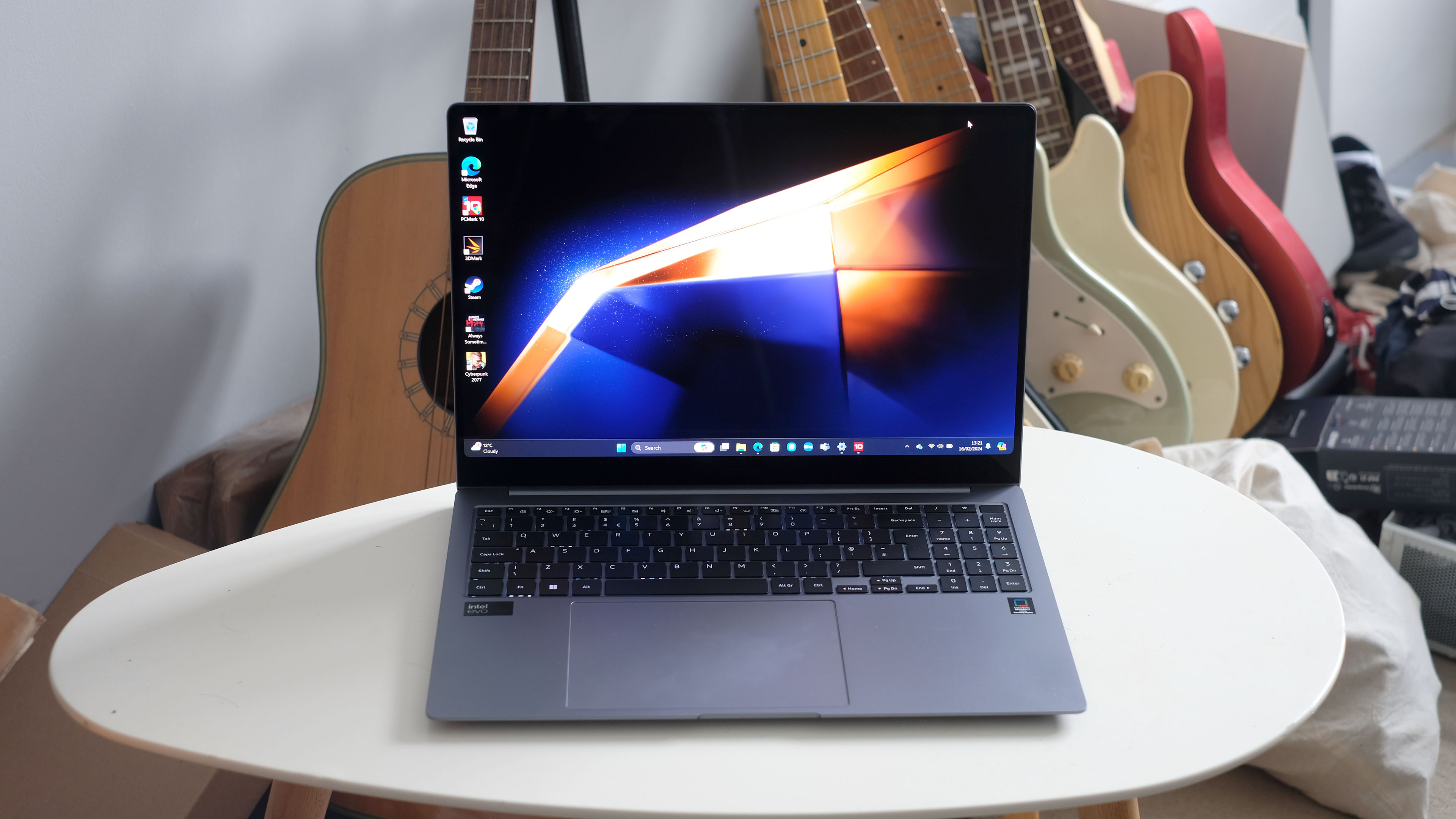
Samsung hasn't made dynamic changes to the Samsung Galaxy Book 4 Pro formula, but Intel's techy progress makes this generation more ready for fun. It looks made for high-flying exec meetings, is surprisingly good for travel considering its size, yet it's now not too bad for light gaming either.
You can get more substantial keyboards, beefier speakers, and some other lines are more aggressive on the value front. But this one squared up pretty well to a MacBook Air 15 – but for the same price you get a cracking OLED display, touchscreen and stylus support.
Also consider
Big screen, big power, sleek styling. You need at least two of those attributes to be a good Samsung Galaxy Book 4 Pro alternative.
The 16-inch MacBook Pro is the most obvious first port of call, but it’s massively more expensive than the Samsung. However, if you drop down to the 15-inch MacBook Air, the two cost the same amount. You probably know already how appealing the Apple ecosystem is to you. Not at all? The Samsung’s benefits are substantial, including an OLED screen with touch and stylus support and more diverse connections.
If you want something significantly lighter, check out the LG Gram Pro. However, judging by our previous experience with the last-generation 16-inch LG Gram, we doubt this new model will feel quite as dense and solid as the Samsung.







